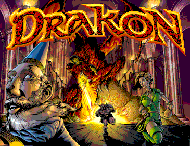
|
About OgreCave and its staff
|

|
by Allan "Sven" Sugarbaker
What's in the Box, Mister? The maze tiles are the heart of the game. These attractively illustrated dungeon intersections each have four passageways either leading to or from the tile. The tiles can be attached to any other tile, as long as none of the arrows on the tiles point toward each other. The other pieces are the heroes and the coins. Each of the six heroes slides into a small plastic base into order to stand up and move about the dungeon maze. I’d suggest leaving the heroes assembled once you've put them together; there’s plenty of space in the box, and repeatedly removing and replacing the plastic base can tear up said heroes almost as quickly as a dragon could. The coins, everyone’s goal in the game, are set aside. By the way, the Drakon box is far larger than the game pieces require. This leaves space for whatever add-on components (dice, a dragon figure that chases the heroes, etc) you might make up rules for. Or you could stuff your Cheetos in there, but I'd suggest using something else to carry the salsa.
Gameplay Each player is dealt some maze tiles, and play begins. On each turn, a hero can move one space or place a maze tile. Obviously no one can move until some tiles are played, so whoever goes first will get to start building the maze. The first few spaces tend to be either neutral spaces, in the hopes of leading other players in that direction, or coin-giving spaces, in the hopes of grabbing a quick lead. In Wiz-War, the randomness is two-fold: you rarely know which way your opponent will go in the maze, and you never know what cards he holds. In Drakon, the cards are the maze, making the board itself unpredictable. Sure, once the maze tiles been placed, the direction an opponent will move is far easier to predict. Thanks to special magical symbols in the center of many tiles, the maze sections can be rotated or rearranged, changing the lay of the land. Tiles can also be removed entirely, possibly stranding a player in his own private Idaho (although he could build his way back). There are 15 types of maze tiles (16 if you include blank tiles); the number and direction of exit arrows on each one adds more variety. Once the players have moved a space or two and split up a bit, the real game begins. Players try to build a series of maze tiles that give them gold as quickly as possible. Some spaces give you a coin, or let you take one from the player on your left or right. Others have more devious effects, allowing you to move another player's hero, get a burst of speed from a magic wind, or teleport to anywhere in the dungeon. Keep the Drakon instruction book handy to interpret the various symbols on each space until they become familiar. Even then, pay careful attention to the nearly identical symbols for Steal a Coin (Left) and Steal a Coin (Right), or risk the wrath of your fellow gamers. In the basic game, there is no functional difference between the six heroes, but the advanced game gives special, one-use abilities to each. The abilities of the Barbarian, Amazon, and Wizard seem to be the most useful: the Barbarian pushes an opponent off his space and takes a coin from them; the Amazon takes two moves in a row; and the Wizard gets to move in a direction that normally isn't legal. However, under the right circumstances any hero’s ability could decide the winner.
Conclusion Drakon strikes me as a cross between two of Tom Jolly's other games, Programmer's Nightmare and Wiz-War. The special instructions on each maze tile can be arranged to create "program loops," a profitable strategy in both Drakon and Nightmare. Breaking (or failing to break) your opponents' loops can make all the difference, as can creating your own. The treasure-gathering and maze-running of Wiz-War has been neatly combined with the ability to program your own maze structure, resulting in a new and enjoyable hybrid. Most importantly, in playing Drakon, I get the same feeling I get when playing Wiz-War: that I'm playing a classic. The game plays smoothly, is easy to learn, and has ample complexity to occupy strategists. Whenever I head out the door to a game convention or night of gaming, Drakon will be one of the games that comes out the door with me. It might not get played every time I bring it, but I can rest assured of having an excellent game on hand, just in case.
|
||||
 Tom Jolly has an excellent track record in game design.
The Diskwars phenomenon, and all of its offshoot games, would not have happened
without him. And let's not forget the near-legendary board game, Wiz-War, whose
fifteen-health-point wizard duels influenced the development of Magic: The
Gathering. With Drakon, Mr. Jolly returns to what he does best: creating an
elegant game of equal parts strategy and luck. The dragon is just a bonus.
Tom Jolly has an excellent track record in game design.
The Diskwars phenomenon, and all of its offshoot games, would not have happened
without him. And let's not forget the near-legendary board game, Wiz-War, whose
fifteen-health-point wizard duels influenced the development of Magic: The
Gathering. With Drakon, Mr. Jolly returns to what he does best: creating an
elegant game of equal parts strategy and luck. The dragon is just a bonus.